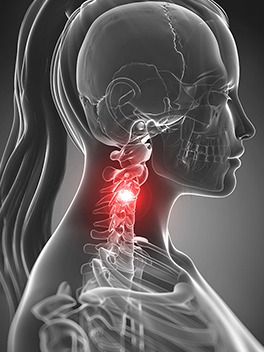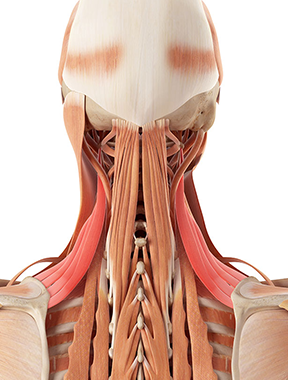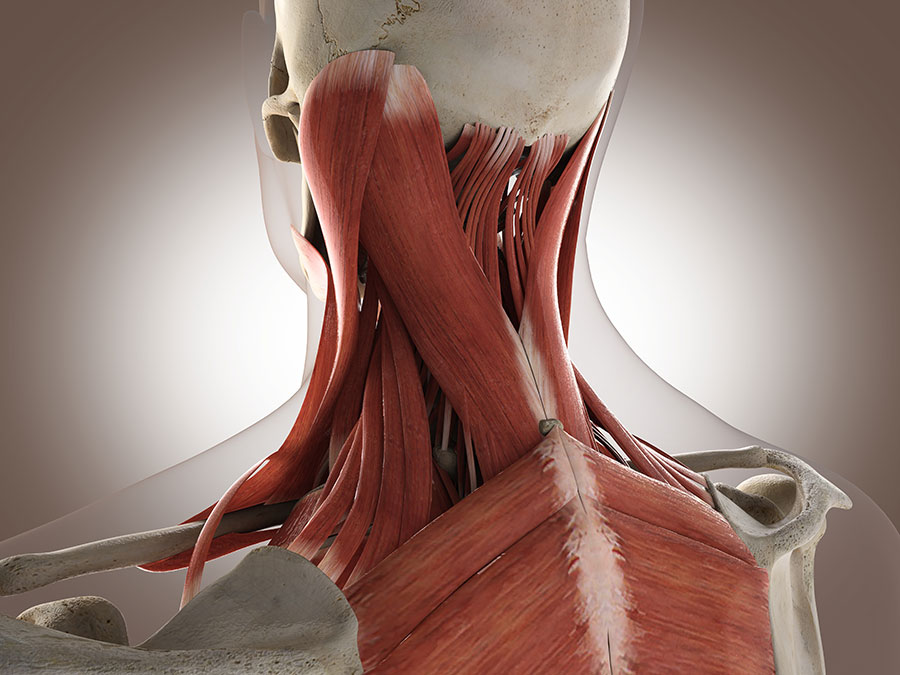If you’re reading this article you (or someone you love) are either suffering from a neck muscle spasm or investigating treatments for a sore or stiff neck. This article is written to help you understand the structure of your neck and how an imbalance causes muscle spasms. If you want to know what happens during a neck muscle injury, keep reading. However, if you are looking for general information about neck pain, we recommend you read our article Neck Pain.
This article provides you with detailed causes of neck muscle spasms and levels of urgency for treating your symptoms. Explanations of our (Cilliers & Swart) diagnosis and treatment processes are included in this article. We’ve also included tips to prevent further injury or recurring injury to your neck muscles.
Note: Keep in mind that your neck muscles have a direct relationship with other parts of your body, like your shoulders and back. This means that a related injury can be causing your neck muscles to stiffen, for example bad back posture can put strain on your neck muscles causing your neck muscles to spasm.
Structures in your neck
Your neck joins your head to your body. Your neck muscles are responsible for moving your head to see and avoid obstacles in your way. Explaining causes of your neck spasm, requires a look at the different structures which make up your neck and their relationship to each other. These structures include neck joints, discs, ligaments, nerves, blood vessels and muscles. You can get sore or stiff neck from damage to any of these structures. Now, let us explore each one individually.
Neck joints (also known as cervical vertebrae)
There are seven cervical vertebrae, counted from the bottom of your skull (C1 & C2) to the middle of your torso (where the thoracic vertebrae start).
The structure of the C1 and C2 vertebrae are unique compared to the other vertebrae. C1 and C2 join to form a pivot joint which allows you to rotate your head from side to side, for example when following the ball during a tennis match.
The vertebrae of C3 to C7 look similar in shape. These vertebrae assist you in looking up or down or bending your neck to touch your ear to your shoulder. All the joints (C1 to C7) need to work in harmony and naturally form a curve, called the cervical lordosis. Injury, damage or displacement (in the curve) of one of these joints can cause a sore or stiff neck.
Interesting fact: The C1 cervical vertebrae is named “Atlas” after the Titan warrior condemned to carry the heavens on his shoulders by Zeus in Greek mythology.
Neck discs
Between each of the previously mentioned cervical vertebra is a disc (except for C1 and C2). These discs are circular in shape and have a tough (stringy) outer layer to protect a soft gel-like inner. When your neck joints are put under pressure (or twist and bend in tricky positions), these discs absorb the tension and act as shock absorbers. Neck discs are prone to tearing. A bulging neck disc can limit the space meant for nerves, essentially pinching the nerve. A pinched nerve is commonly known as a “slipped disc” and can be very dangerous.
Neck ligaments
The cervical vertebrae and neighbouring discs are connected to each other with different ligaments to help stabilise your head and body as you move. When ligaments are too loose, they struggle to steady your movements. Stretching and compressing ligaments can cause damage and result in pain. The most common sudden neck pain injuries (regarding ligaments) includes whiplash, falling or tackling. Together, the neck joints (bony bits), discs and ligaments keep the spinal cord safe by controlling your range of movement.
Spinal cord & nerves
A round channel is seen when looking at your spine from above. This ‘hole’ runs from your brain to your lower back and provides the space needed for your nerves (grouped together to form your spinal cord). Above (C1 to C7) or below (C7) each vertebra the nerves branch out, forming nerve roots. These nerve roots merge and divert to supply and relay messages of sensation from limbs (like your arms) to the brain. These nerves can be scratched or irritated by surrounding structures. For example, a bulging neck disc can take up space meant for nearby nerves, essentially pinching the nerve.
Neck blood vessels
Alongside the vertebrae run important blood vessels supplying your brain with oxygen rich blood. Interrupting the blood supply is potentially devastating. Blockages in the vessels or pooling of blood (in the tissues) can put pressure on the other neck structures causing pain. Blood vessels nearest to your skin’s surface are in the area just below your jawbone, where you can feel your pulse (if you press gently with your index finger).
Neck muscles
18 muscles attach to the seven neck vertebrae and the skull. These muscles pull together or stretch in harmony to create movement, allowing you to move your neck on your shoulders.
The common muscle injuries to the back of patients’ necks are:
- Upper fibers of trapezius
When looking up or shrugging your shoulders, these muscles are used. - Levator scapulae
When shrugging your shoulders, these muscles are involved. - The suboccipital group
Injuring these muscles often causes a headache at the base of the skull. - Rhomboids
The muscles between your shoulder blades feeling tired and tight after a long day behind a desk.
The common muscle injuries to the front of patients’ necks are:
- Sternocleidomastoid
These muscles are used when rotating your head or looking from side to side - Scalenes
When bending your neck, you use these muscles e.g. to look down or over your shoulder
Note: Injuring muscles at the front of your neck may not result in pain. However, pay close attention because such an injury could be contributing to muscular pain or headaches in your temples.
Causes of a neck muscle spasm
Muscles spasms can be the result of injuring or straining your neck muscles for example. turning your head to have a chat with the person sitting next to you. In this example, your neck muscles tire and spasm because they can’t sustain the constant tension over time. This can leave your muscles feeling stiff or sore long afterwards.
Causes of stiff neck muscles vary depending on the damage or injury to the underlying structures. These structures include neck joints, discs, ligaments, nerves, blood vessels and muscles (see the previous section). The moment of injury is important to keep in mind. For example, treating neck muscles from years of bad posture is different compared to treating neck strain from a sudden unexpected force (like whiplash).

We hear these types of stories about how patients get neck spasms:
- flipping their hair back while drying it
- turning their head quickly to admire a passing jogger or car
- painting their ceiling
- washing and hanging their curtains
- falling asleep on a couch in an uncomfortable position
- caught badly in a scrum
- recovering from a car accident
- coughing for long periods at a time
- twisting or bumping their head into their shoulder while standing
No matter what your story is, we can help you get relief from your neck spasm or help you loosen your stiff neck muscles.
Cervical muscles can spasm or cramp because of:
- Overuse
E.g. a rigorous exercise routine involving a large volume of sit-ups - Fatigue because of sustaining a position for too long
E.g. bad posture sitting at your desk or clutching a phone between your ear and shoulder - Dehydration and electrolyte imbalances
- Overstretching
E.g. sleeping in an awkward position - Previous injury
E.g. whiplash, a concussion or fall
Why neck muscles tend to spasm after an injury?
Your muscles help you minimise injury and help you defend yourself (e.g. stretching out your hands and arms when you fall of your bike). Muscles help you move away from harm or danger. After an injury, neck muscles can go into a protective spasm. Spasms are your muscles’ way of protecting you’re the injured area or the underlying structures, for example joints, ligaments, discs or nerves . Therefore, it is important to get a chronic spasm checked out by a medical professional to make sure that the spasm isn’t a symptom of something more serious.
Symptoms of a neck muscle injury
Fill out our free Call Back form and we’ll call you back to discuss your situation. Alternatively, give us a call so that we can advise you on your situation or refer you to the right health care professional – especially if you are experiencing the more serious symptoms listed above.
Diagnosing a neck muscle injury
Using tests, screening technologies and scans we (at Cilliers & Swart Physiotherapy) make sure that we understand your unique situation and symptoms. You can expect us to test your muscles, joints, nerves, ligaments and tendons in the area affected. These tests give us a better understanding of your unique injury and helps in identifying the damaged underlying structure causing you pain.
Concerning neck spasms or neck muscle injuries, we also look at your back and shoulders because of their direct relationship with your neck. If you have any previous sonars, X-rays, MRIs, CT scans which are relevant – you are welcome to bring them along.
X-ray
Soft tissues, like muscles, aren’t visible on X-rays. If we suspect a muscle is injured, it is not necessary to go for X-rays. X-rays only show us the integrity (state) and alignment of the cervical vertebrae (joints).
MRI
A health care specialist’s referral is needed for an MRI scan. An MRI scan helps us see all the structures in the neck, including the muscles. If there is a tear in the neck muscle, an MRI scan will show exactly where it is. This is a very costly procedure. An alternative (less expensive option) is the use of sonar.
Sonar
Sonar shows a clear picture of the soft tissue in the neck. If there is a tear, bruise or inflammation within a muscle, sonar imaging will identify the specific area, depth and length of the muscle problem. We have a sonar facility at our practice and its use will be included in your treatment fee.

No relief from neck spasms?
Your symptoms may have started as ‘the occasional stiff or sore neck’ and progressed to a more intense pain that become constant. No muscle will stay in spasm without reason. Your muscles may be protecting an injured disc, joint or nerve root. Without identifying and treating the cause of your pain, it will keep coming back. Additionally, neck muscle pains can lead to cervicogenic headaches.
We can help you get to the bottom of what is causing your neck muscles to spasm, stiffen or pain. Your posture or habits (longs hours behind a desk or computer) could be worsening your symptoms.
If you suffer from chronic muscular pain in your neck, we ask you to give us a call or fill out our free call back form (and we’ll call you back). The longer you wait to get treatment, the more likely you are to spend more money and time on recovering from your original injury.
Recovery time
Neck muscles can be injured in many ways and result in feelings of stiffness or pain. Early diagnosis and professional treatment of an injury is the best possible way to ensure a full and quick recovery.
Moderate neck muscle pain typically improves within a week or two after injury – only if you manage it properly. However, when a muscular pain or spasm lasts more than a few days it points to a more significant injury which should be professionally investigated and diagnosed.
Most patients suffering from a strained neck recover within 4 to 6 weeks. However, this time can vary because it depends on both the nature of your injury and the treatment plan that you develop with your physiotherapist.
How to prevent a Recurring Neck Injury?
If you have suffered neck pain and spasm in the past, you are more likely to suffer similar injuries in the future. The most common reason for recurring neck pain is insufficient rehabilitation. At Cilliers & Swart you develop a treatment plan with your preferred Physiotherapist. You then agree to follow the advice of your Physiotherapist in order to achieve your short-term or long-term goals and help prevent a recurring injury.
We advise you to discuss your daily postures and activities with your physiotherapist . Your Physiotherapist will help you understand how to position yourself, how to move and how to keep your risk of injury low, while taking into consideration your type of injury and potential weaknesses.
While there are no guarantees, it is well known that individuals who exercise regularly and adopt safe movement routines (e.g. controlled lifting of weights) and postures at home and at work reduce their risk of recurring neck pain or neck spasms.
What else could the pain be?
- Spondylosis
Spondylosis describes the normal process of aging (wearing and tearing) of the vertebrae, which is expected with age, like grey hair. It leads to feelings of stiffness, especially in the morning.
- Cervical disc bulge/protrusion
Injured discs cause high intensity pain. In cases, when the nerve root is compressed by the disc, the pain is clear in your arm or hand compared to your neck. Symptoms include pins and needles, numbness, weakness or a loss of sensation. - Locked cervical facet joint
Happens suddenly, usually with a memorable movement (strain) of your neck, leaving you unable to move your head at all because of the pain. - Cervicogenic headaches
Structures in the neck causing headaches. These headaches are usually experienced on only one side of your head and directly influenced by the position of your neck. - Whiplash
The sudden impact of a car accident may cause your neck to forcefully be jerked (back to front). This may cause severe muscular pain, spasms and even hypersensitivity to touch.
Related articles/injuries
- Neck Joint Degeneration (Cervical Spondylosis)
- Cervical Disc injury (Slipped neck disc)
- Interspinous ligament sprain
- Pinched nerve
- Cervical Facet joint sprain (Bone)
- Neck Pain
- Whiplash
For any related information about neck spasm treatment or neck muscle treatment contact us or fill out our free Call Back form (we’ll call you). If you’ve already made up your mind to book an appointment with us but would like to know more about our fees, please click on the button below.


